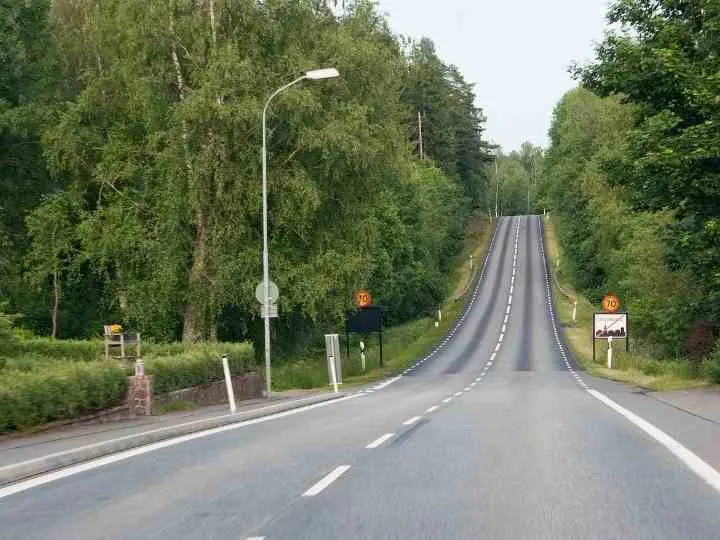When you are driving down a highway, using the cruise control function on your car can make your trip much easier.
However, you may be curious as to whether you can use cruise control in other situations, such as when driving on hills.
Should you use cruise control on hills?
Cruise control is better suited for use on flat or relatively flat terrain, as leveraging cruise control on steep hills can result in more wear and tear on the engine’s transmission. Additionally, descents may result in your vehicle exceeding the desired speed.
Keep reading to learn more about using cruise control on hills!
Why Should I Use Cruise Control On Hilly Roads?

If you are very experienced using the cruise control function on your car, you may have few issues using it on hills. However, according to most car experts we’ve talked this over with, it is usually best if you refrain from using cruise control on hills.
Even adaptive cruise control (ACC) systems should not be used on hills.
When you are driving on a hill, we recommend you use your car’s brakes and accelerator to manually let you control your speed.
This can be important not only when you are going uphill, but downhill as well.
When you are going uphill and have the cruise control activated on your car, this may result in your vehicle failing to accelerate as may be needed.
Should this occur, you could find your car going much slower than other vehicles around you, creating a hazard that could lead to an accident.
If you are going downhill and have your car on cruise control, your car may do the opposite and speed up very quickly, catching you by surprise.
When this happens on a very steep downhill grade, your car will actually be going faster than the cruise control speed and posted speed limits for the road, also increasing the chances you may suffer a serious auto accident.
Using cruise control on hills can also have your vehicle going through multiple transmission shifts much quicker than it normally would.
Not only does this give you far less control over your car’s speed and handling, but it also results in more wear and tear on your engine and transmission, which could lead to expensive repair jobs.
Can Cruise Control be Used on Hills?
Since cruise control was designed primarily to be used only when you are driving your car on flat roads where you won’t be encountering traffic congestion, it is usually recommended that it not be used on hilly terrain.
But while you are now assuming there are no situations where you can use cruise control on hills, that is actually not the case.
If you are driving up or down a hill that is not extremely steep, has little if any traffic congestion, and features no sharp turns or one incline after another, you may be able to use your cruise control safely.
In fact, you can do so and find it will be very fuel-efficient.
Should the hills you will be encountering be extremely steep or have roads that are twisting and turning, we suggest you deactivate your cruise control so that you stay as safe as possible while behind the wheel.
Does Cruise Control Save Gas on Hills?
Under certain situations, you can use cruise control to save gas when driving up or down hilly terrain.
If you have a car with high-quality cruise control, your owner’s manual may state that it is capable of handling hills that you may suddenly encounter when on the road.
However, this may or may not be the case.
Should you be driving on flat roads while using cruise control, most experts agree the average driver can expect to use 15% less gas than they would without cruise control.
But when going up or down hills, the cons far outweigh the pros regarding the use of cruise control to save gas.
When you try activating your cruise control on hills, you’ll risk having your vehicle either slowing down too much when going uphill, or instead speeding up far too much on a steep downhill grade.
Since this won’t allow you to maintain sufficient control over your vehicle and puts much more strain on your car’s engine and transmission, any money you may save on gas while driving on hills may be eaten up by repair costs to your transmission and engine.

When Should Cruise Control Not be Used?
Even if you are a good driver, have a vehicle that handles well under adverse conditions, and are very experienced using your cruise control, there are still certain conditions where you should not use your cruise control.
To begin with, we recommend you not use your cruise control when you are driving during the winter, especially if the roads are covered with snow or ice.
If you try to use cruise control under these conditions, the chances of your vehicle losing control increase dramatically.
Also, it’s best to not use your cruise control in warmer weather when the roads are wet from the rain.
Under these conditions, your car could hydroplane while in cruise control, likely resulting in you having an accident.
Can Cruise Control be Bad for Your Car?
When you use your car’s cruise control under normal conditions for which it was designed, it will not be bad for your engine, transmission, brakes, or other parts of your car.
In fact, it may actually decrease the wear and tear on your car when used properly.
When you use cruise control, you don’t have to rely as much on your brakes, which in turn puts less strain on your engine and transmission.
When combined with the fact that you may save as much as 15% on the amount of gas you use while on the road, knowing how to use your cruise control can pay off in more ways than one.
Though it’s best to not activate your cruise control when driving up or down most hills, it can come in handy under the right conditions.
If you are driving on dry roads, won’t be encountering large amounts of traffic along the way, and will be in an area that does not have one sharp turn or incline after another, your cruise control may make your trip easier.
